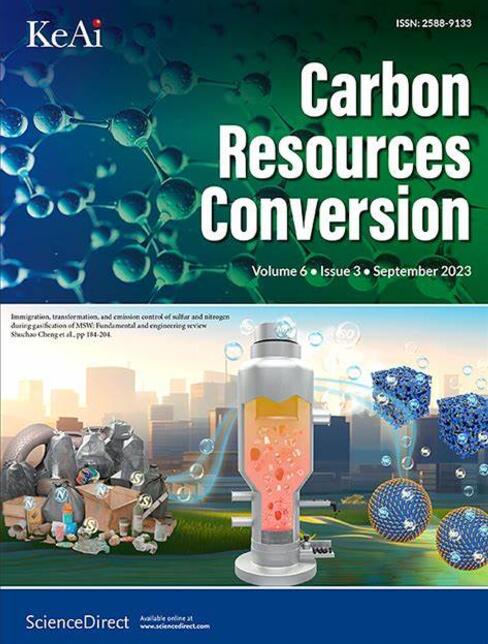A non-aseptic bioprocess for production and recovery of 2,3-butanediol via conversion of crude glycerol and corn steep liquor at pilot-scale
IF 7.5
3区 环境科学与生态学
Q2 ENERGY & FUELS
引用次数: 0
Abstract
The production and recovery of 2,3-butanediol (BDO) through biodiesel derived glycerol valorization by Klebsiella oxytoca ACA-DC 1581 was holistically optimized with regard to the efficiency and cost of the bioprocess. The absence of thermal treatment of the substrate had no negative effect upon the growth of microorganism and the bioconversion of crude glycerol into BDO, enabling the development of a non-aseptic and lower-cost bioprocess. Both digestate and corn steep liquor (CSL), the main by-products of the biogas and corn industries respectively, successfully served as the sole source of nitrogen, contributing to the complete replacement of more expensive sources (e.g., yeast extract). The biochemical pathway of glycerol catabolism was examined under varying concentrations of dissolved oxygen and BDO production was optimized in a fully aerobic environment (volumetric mass transfer coefficient; kLa = 70.5 1/h.) The glycerol consumption rate was 2.80 g/L/h, the BDO productivity reached 1.12 g/L/h and the yield of BDO produced per unit of glycerol consumed was 0.46 g/g, with these values being among the highest ones reported in the literature for wild-type strains cultivated on crude glycerol. In all fed-batch fermentations, final BDO and acetoin concentration reached ∼80 g/L, while a plateau was observed at ∼68 g/L of BDO. Finally, the culture was carried out efficiently in the pilot-scale reactor (250 L). The salting-out extraction (SOE), consisting of ethanol (24 %) and K2HPO4 (25 %), recovered 91.7 % of BDO from the fermentation medium and was studied for the first time in a glycerol-based medium. The study suggests the potential industrialization of the bioprocess through sustainable, pilot-scale and low-cost bioconversion of biodiesel-derived crude glycerol and CSL or digestate into BDO.

通过中试规模的粗甘油和玉米浸出液转化生产和回收 2,3-丁二醇的非无菌生物工艺
从效率和成本两方面全面优化了由氧化克雷伯菌ACA-DC 1581制备生物柴油衍生甘油的工艺。没有热处理的底物对微生物的生长和粗甘油转化为BDO没有负面影响,使得开发一种非无菌和低成本的生物工艺成为可能。沼液和玉米浆(CSL)分别是沼气工业和玉米工业的主要副产品,它们成功地作为氮的唯一来源,有助于完全取代更昂贵的来源(如酵母提取物)。研究了不同溶解氧浓度下甘油分解代谢的生化途径,并在全有氧环境下优化了BDO的生成(体积传质系数;kLa = 70.5 1/h。)甘油消耗速率为2.80 g/L/h, BDO产量为1.12 g/L/h,单位甘油消耗产生的BDO产量为0.46 g/g,这些数值是文献报道的以粗甘油培养的野生型菌株中最高的。在所有补料间歇发酵中,最终的BDO和乙酰酶浓度达到~ 80 g/L,而在BDO的~ 68 g/L时观察到一个平台。最后,在250 L的中试反应器中进行了高效的培养。由乙醇(24%)和K2HPO4(25%)组成的盐析萃取(SOE)从发酵培养基中回收了91.7%的BDO,并首次在甘油基培养基中进行了研究。该研究表明,通过可持续、中试规模和低成本的生物转化,将生物柴油衍生的粗甘油和CSL或消化物转化为BDO,可以实现生物工艺的工业化。
本文章由计算机程序翻译,如有差异,请以英文原文为准。
求助全文
约1分钟内获得全文
求助全文
来源期刊

Carbon Resources Conversion
Materials Science-Materials Science (miscellaneous)
CiteScore
9.90
自引率
11.70%
发文量
36
审稿时长
10 weeks
期刊介绍:
Carbon Resources Conversion (CRC) publishes fundamental studies and industrial developments regarding relevant technologies aiming for the clean, efficient, value-added, and low-carbon utilization of carbon-containing resources as fuel for energy and as feedstock for materials or chemicals from, for example, fossil fuels, biomass, syngas, CO2, hydrocarbons, and organic wastes via physical, thermal, chemical, biological, and other technical methods. CRC also publishes scientific and engineering studies on resource characterization and pretreatment, carbon material innovation and production, clean technologies related to carbon resource conversion and utilization, and various process-supporting technologies, including on-line or off-line measurement and monitoring, modeling, simulations focused on safe and efficient process operation and control, and process and equipment optimization.
 求助内容:
求助内容: 应助结果提醒方式:
应助结果提醒方式:


